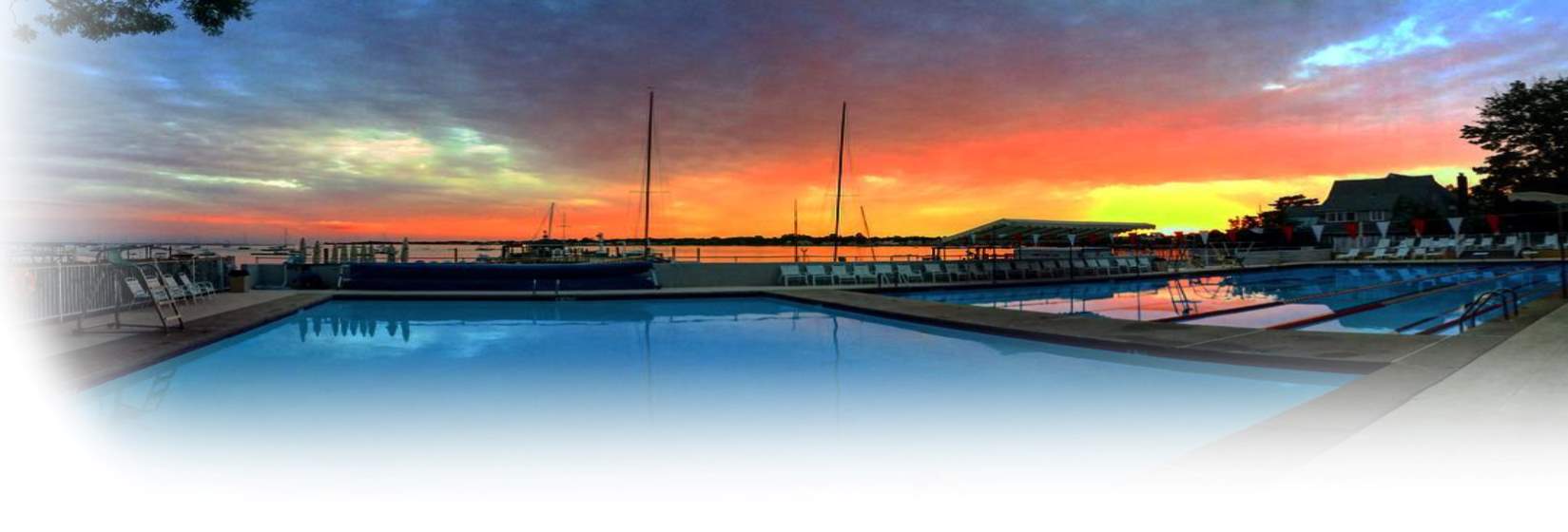9/19/2017

STAMFORD YACHT CLUB POOLS
Much of what our Club is today was conceived in 1890 and implemented over the next few years. One surprising exception are our swimming pools.
There is no hint in meeting records from 1890-1928 that the Club considered having a swimming pool. We had bath houses, of course, but early member families were satisfied with swimming from the beach and diving from the dock. The water was much deeper.
Due to increasing population and industrialization, coupled with short-sighted policies and a lack of regulation, the Harbor’s water quality declined and there were occasional health-related scares. We know that happened in 1929, because a Dr. Fear wrote to our Board of Directors in late July, offering his assurance that a prohibition of swimming was not necessary. This concern may explain why, in May of that year, the board formed a committee to investigate the possibility of building a swimming pool. The board was also concerned about competition from the Shippan Beach Club (today’s Woodway).
On July 11, the committee reported that a submerged pool would cost over $40,000, but a guest was introduced to describe an alternative. He was Wesley Bintz, who had given up his engineering career in Michigan to sell his patented above-ground pool designs. Mr. Bintz told the Board he could provide just as large a pool for about $27,000. Our records do not show whether the Club engaged Mr. Bintz, but we know the first pool’s design was influenced by his message: excavation is expensive.
In September, the pool committee was authorized to spend up to $500 for an engineering study. On October 10, the board resolved to solicit member subscriptions (donations) to raise $40,000 for a pool. That was just 19 days before Black Tuesday, so we might expect to find a later reversal of that decision. Yet, at the November board meeting, the pool committee reported 45-50 pledges, averaging $145. Subscriptions doubled over the next three months, despite resistance from members who advocated a general assessment. In February, the board authorized the drawing of plans.
A contract was signed in April 1930. The pool was designed to be 4’ above ground level, which reduced the estimated cost to about $25,000. The board decided to lower the pool by 18”, at some additional cost, to make it consistent with the level of the tennis courts and buildings. The Commodore finished the subscription campaign by writing to members who lived in Shippan, reminding them that the Club’s pool would enhance their property values.
Members contributed about $16,000 and the Club borrowed the balance, in the naïve belief that charges for pool use would take care of the loan. Someone thought it would appear more member-friendly to charge for the use of towels and lockers, so that was tried. Local members quickly adapted by changing at home, and the Club lost over 250 towels in the pool’s first summer.
The new pool’s second season ended in tragedy in September 1931, when Walter C. Allen, Jr., son of Yale & Towne’s President, dove too deeply from the pool’s diving board, breaking his neck and dying.
The Club boasted that harbor water was constantly fed to the pool through a filtration system. That system was beset with problems and it was not long before health concerns dictated the installation of chlorinators, so pool maintenance was always a shock to the annual budget.
The addition of a wading pool had been discussed ever since 1931, but it was not built until 1959, when Andrei Kristopher donated the necessary funds in memory of his mother, Bertha Draper.
The inefficiently collected pool-related fees were finally abandoned in 1953, replaced by a $20 dues increase. But, later that year, it was discovered that the pool’s expansion joints had been cemented by a well-meaning staff member, leading to a catastrophic failure of the structure’s underpinnings. The anticipated cost was so great that the pool committee was asked to solicit member subscriptions again.
Next time you cool off in one of the Club’s pools, remember all those earlier members who made it possible.
Staff Commodore Christopher Hynes
Club Historian